List of works by Diego Velázquez
Appearance
This is a list of paintings and drawings by the 17th-century Spanish artist Diego Velázquez. Velázquez is estimated to have produced between only 110 and 120 known canvases.[1] Among these paintings, however, are many widely known and influential works.
All paintings are in oil on canvas unless noted.
Seville (until 1622)
[edit]| Painting | Title | Date | Dimensions (cm) | Collection | Notes | Catalog numbers: Morán–Sánchez/López-Rey |
|---|---|---|---|---|---|---|

|
Three Musicians | 1617–1618 | 87 × 110 | Staatliche Museen, Berlin | 1/1 | |

|
The Lunch | c. 1618 | 108.5 × 102 | Hermitage, Saint Petersburg | 2/3 | |

|
La mulata | c. 1620 | 55 × 118 | National Gallery of Ireland, Dublin | The dates proposed by critics range from 1617 to 1622. | 3/17 |

|
Old Woman Cooking Eggs | 1618 | 100.5 × 119.5 | National Gallery of Scotland, Edinburgh | Dated in the lower right corner. | 5/6 |

|
Christ in the House of Martha and Mary | 1618 | 60 × 103.5 | National Gallery of London | Dated. | 6/7 |

|
Dos jóvenes a la mesa | 1622 | 65.3 × 104 | Apsley House, London | 9/24 | |

|
Saint Thomas | 1619–1620 | 95 × 73 | Musée des Beaux-Arts d'Orléans, Orléans | 10/10 | |

|
Immaculate Conception | 1619 | 135 × 101.6 | National Gallery of London | 11/11 | |
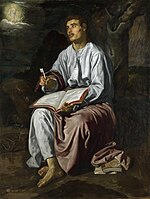
|
San Juan en Patmos | 1619 | 135.5 × 102.2 | National Gallery of London | 12/12 | |

|
Adoration of the Magi | 1619 | 204 × 126.5 | Museo del Prado, Madrid | Dated in the stone under the foot of the Virgin. | 13/13 |

|
Saint Paul | 1619–1620 | 99 × 78 | Museu Nacional d'Art de Catalunya, Barcelona | 14/14 | |

|
Cabeza de apóstol | 1622 | 38 × 29 | Museo del Prado, Madrid | 15/15 | |

|
The Waterseller of Seville | 1620 | 106.7 × 81 | Apsley House, London | 16/16 | |

|
Don Cristóbal Suárez de Ribera | 1620 | 207 × 148 | Museum of Fine Arts of Seville | Signed and dated in a fold of clothing difficult to read.[2] This would be a posthumous portrait, as the sitter died in 1618, although Mayer thought that monogram and date could be apocryphal.[3] | 17/19 |

|
La venerable madre Jerónima de la Fuente | 1620 | 162 × 107 | Museo del Prado, Madrid | Signed and dated "Diego Velazquez f. 1620". The phylactery around the cross with its inscription, now illegible, was erased in 1944, after entering at the Museum, for having believed apocryphal.[4] | 18/20 |

|
La venerable madre Jerónima de la Fuente | 1620 | 162.5 × 105 | Colección Fernández Araoz, Madrid | Signed and dated "Diego Velazquez f. 1620". Added at a later date under the hand of others.[5] | 19/21 |

|
Imposición de la casulla a San Ildefonso | 1620–1623 | 166 × 120 | Municipality of Seville | In poor condition with significant loss of paint. | 20/22 |

|
Retrato de caballero/Francisco Pacheco | 1620–1622 | 40 × 36 | Museo del Prado, Madrid | 21/23 |
Madrid (1622–1629)
[edit]| Painting | Title | Date | Dimensions (cm) | Collection | Notes | Catalog numbers: Morán–Sánchez/López-Rey |
|---|---|---|---|---|---|---|

|
Portrait of Don Luis de Góngora | 1622 | 50.3 × 40.5 | Museum of Fine Arts, Boston | 22/25 | |

|
Retrato de hombre | 1623–1624 | 55.5 × 38 | Museo del Prado, Madrid | Allende-Salazar (1925), Mayer (1936) and Camón Aznar estimate that this could be a self-portrait. López-Rey and Brown think that the subject could be the artist's brother Juan, also a painter.[6] | 24/27 |

|
Felipe IV | 1623–1624 | 61.6 × 48.2 | Meadows Museum, Dallas | Brown believes that this may be a portrait of the king,[7] a hypothesis rejected by López-Rey.[8] | 25/28 |
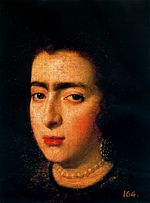
|
Retrato de dama | 1625 | 32 × 24 | Once in the Royal Palace of Madrid. Current whereabouts unknown (stolen from Greenville Art Museum in South Carolina on July 8, 2010) | This is a fragment of a larger portrait probably damaged in the fire of Alcazar.[9] | 28/31 |

|
Cabeza de venado | 1626–1628 | 58 × 44.5 | Museo del Prado, Madrid | Dating is controversial. Most critics suggest 1635.[10] López-Rey gives 1626, based on 1637 information from a picture of a deer antler painted by Velázquez bearing the inscription "Le mató el Rey nuestro Sr. Phe. quarto el year 1626".[11] A technical study by Carmen Garrido placed the date between 1626 and 1628.[12] | 31/33 |

|
Cristo contemplado por el alma cristiana | 1626–1628 | 165 × 206.4 | National Gallery of London | 32/35 | |

|
Felipe IV | 1623–1628 | 198 × 101.5 | Museo del Prado, Madrid | 33/36 | |

|
Portrait of the Infante Don Carlos | 1626–1628 | 209 × 12 | Museo del Prado, Madrid | 34/37 | |

|
Portrait of Philip IV in Armour | c. 1628 | 57 × 44.5 | Museo del Prado, Madrid | This is considered a fragment of a larger work painted in two stages, reforming the dress and adding the red band in the second.[13] | 35/38 |

|
Demócrito/El geógrafo | 1628–1629 | 101 × 81 | Musée des Beaux-Arts de Rouen | Head and hand repainted around 1640. Radiography shows the left hand formerly contained a drink, as it appears in two copies preserved.[14] | 37/40 |

|
The Triumph of Bacchus | 1628–1629 | 165.5 × 227.5 | Museo del Prado, Madrid | 38/41 | |

|
La cena de Emaús | 1628–1629 | 123.2 × 132.7 | Metropolitan Museum of Art, New York City | Proposed dates range from 1619 (Lafuente Ferrari) to a time immediately after the first trip to Italy (Marias).[15] | 39/42 |
First trip to Italy (1629–1630)
[edit]| Painting | Title | Date | Dimensions (cm) | Collection | Notes | Catalog numbers: Morán–Sánchez/López-Rey |
|---|---|---|---|---|---|---|

|
Portrait of Maria Anna | 1630 | 59.5 × 45.5 | Museo del Prado, Madrid | 40/48 | |

|
Joseph's Tunic | 1630 | 223 × 250 | El Escorial, San Lorenzo de El Escorial | 41/43 | |

|
Apollo in the Forge of Vulcan | 1630 | 222 × 290 | Museo del Prado, Madrid | 42/44 | |

|
Cabeza de Apolo | 1630 | 36 × 25 | Private collection, New York City | Considered a study for Apollo in the Forge of Vulcan.[16] | 43/45 |

|
El Pabellón de Cleopatra-Ariadna | 1630 | 44.5 × 38.5 | Museo del Prado, Madrid | The dating of this painting and the next has been controversial. Most critics date it during the second trip to Italy, but technical studies by in the Prado confirm the 1630 date proposed by López-Rey.[17] | 44/46 |

|
View of the Garden of the Villa Medici | 1630 | 48.5 × 43 | Museo del Prado, Madrid | 45/47 |
Madrid (1631–1648)
[edit]| Painting | Title | Date | Dimensions (cm) | Collection | Notes | Catalog numbers: Morán–Sánchez/López-Rey |
|---|---|---|---|---|---|---|

|
A Sybil (Juana Pacheco?) | 1630–1631 | 62 × 50 | Museo del Prado, Madrid | 46/49 | |

|
Retrato de hombre joven | 1630–1631 | 89.2 × 69.5 | Alte Pinakothek, Munich | Appears unfinished, with the hands just sketched, although López-Rey suggests that Velázquez may have intended this as a finished work, highlighting the essential features of the portrait.[18] | 47/50 |

|
Temptation of St. Thomas | 1631–1632 | 244 × 203 | Museum of the Orihuela Cathedral, Orihuela | 48/130 | |

|
Prince Balthasar Charles With a Dwarf | 1631 | 128.1 × 102 | Museum of Fine Arts, Boston | 49/51 | |

|
Philip IV in Brown and Silver | 1631–1632 | 199.5 × 113 | National Gallery of London | 50/52 | |

|
Isabel de Borbón | 1631–1632 | 207 × 119 | Private collection, New York City | 51/53 | |

|
Don Diego del Corral y Arellano | 1631–1632 | 205 × 116 | Museo del Prado, Madrid | 52/55 | |

|
Doña Antonia de Ipeñarrieta y Galdós and Her Son Don Luis | 1631–1632 | 205 × 115 | Museo del Prado, Madrid | Brown suggestions that a contemporary workshop was involved in the painting of lady's costume and the figure of the child; changes once thought to be later additions, but denied by radiography.[19][20] | 53/54 |

|
Mano de hombre | 1630 | 27 × 24 | Unknown; previously Royal Palace of Madrid | 54/56 | |

|
Don Pedro de Barberana y Aparregui | 1631–1632 | 198.2 × 111.8 | Kimbell Art Museum, Fort Worth, Texas | 55/57 | |

|
Don Juan Mateos | 1632 | 108 × 90 | Dresden Gallery, Dresden | The hands are only outlined, but with a touch of white light which suggests that Velázquez considered the work finished in that state. | 56/58 |

|
Christ Crucified | 1632 | 250 × 170 | Museo del Prado, Madrid | 57/59 | |

|
Retrato del príncipe Baltasar Carlos | 1632 | 117.8 × 95.9 | Wallace Collection, London | 58/60 | |

|
Felipe IV | 1632 | 127.5 × 86.5 | Kunsthistorisches Museum, Vienna | Generally considered the work of Velázquez and his workshop.[21] For López-Rey only the head and some small details could be considered by Velazquez.[22] | 59/61 |

|
Isabel de Borbón | 1632 | 132 × 101.5 | Kunsthistorisches Museum, Vienna | 60/62 | |

|
The Jester Named Don John of Austria | 1632–1633 | 210 × 124.5 | Museo del Prado, Madrid | 61/65 | |
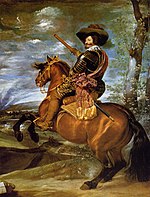
|
Equestrian Portrait of the Count-Duke of Olivares | 1634 | 314 × 240 | Museo del Prado, Madrid | 62/66 | |

|
White Horse | 1634–1638 | 310 × 245 | Royal Collections Gallery, Madrid | 63/67 | |

|
Equestrian Portrait of Philip III | 1634–1635 | 305 × 320 | Museo del Prado, Madrid | 64/68 | |

|
Equestrian Portrait of Margarita of Austria | 1634–1635 | 302 × 311.5 | Museo del Prado, Madrid | Velazquez and workshop. | 65/69 |

|
Equestrian Portrait of Elisabeth of France | 1634–1635 | 304.5 × 317.5 | Museo del Prado, Madrid | Velazquez and workshop.[23] | 66/70 |

|
Equestrian Portrait of Philip IV | 1634–1635 | 305.5 × 317.5 | Museo del Prado, Madrid | 67/71 | |

|
Equestrian Portrait of Prince Balthasar Charles | 1634–1635 | 209.5 × 174 | Museo del Prado, Madrid | 68/72 | |

|
The Surrender of Breda | 1634–1635 | 307.5 × 370.5 | Museo del Prado, Madrid | 69/73 | |

|
Portrait of Juan Martínez Montañés | 1635–1636 | 110.5 × 87.5 | Museo del Prado, Madrid | 70/76 | |

|
Felipe IV cazador | 1632–1633 | 189 × 124.5 | Museo del Prado, Madrid | 71/63 | |

|
El cardenal infante don Fernando de Austria cazador | 1632–1633 | 191.5 × 108 | Museo del Prado, Madrid | 72/64 | |

|
Prince Balthasar Charles as a Hunter | 1635–1636 | 191 × 102 | Museo del Prado, Madrid | 73/77 | |

|
El príncipe Baltasar Carlos en el picadero (Prince Baltasar Carlos in the Riding School) | 1636 | 144 × 96.5 | Duke of Westminster Collection, London | 74/78 | |

|
The Lady with a Fan | 1635 | 95 × 70 | Wallace Collection, London | 75/79 | |

|
The Needlewoman | 1635–1643 | 74 × 60 | National Gallery of Art, Washington D.C. | Unfinished and of uncertain date. | 77/81 |

|
Portrait of Pablo de Valladolid | 1636–1637 | 213.5 × 125 | Museo del Prado, Madrid | 78/82 | |

|
The Jester Calabacillas | 1637–1639 | 105.5 × 82.5 | Museo del Prado, Madrid | 79/83 | |

|
The Jester Barbarroja | 1637–1640 | 200 × 121.5 | Museo del Prado, Madrid | 80/84 | |

|
San Antonio Abad y san Pablo ermityear | 1635–1638 | 261 × 192 | Museo del Prado, Madrid | 81/85 | |

|
Portrait of the Count-Duke of Olivares | 1638 | 67 × 54 | Hermitage Museum, Saint Petersburg | 82/87 | |

|
Francesco I d’Este | 1638 | 68 × 51 | Galleria Estense, Modena | 84/89 | |

|
El príncipe Baltasar Carlos | 1639 | 128.5 × 99 | Kunsthistorisches Museum, Vienna | Velázquez and workshop.[24] | 86/90 |

|
Retrato de hombre | 1635–1645 | 76 × 64.8 | Apsley House, London | 87/91 | |

|
Aesop | 1639–1641 | 179.5 × 94 | Museo del Prado, Madrid | Inscription at top right: "AESOPVS". | 88/92 |

|
Menipo | 1639–1641 | 178.5 × 93.5 | Museo del Prado, Madrid | Inscription at top left: "MOENIPVS". | 89/93 |

|
Mars Resting | 1639–1641 | 181 × 99 | Museo del Prado, Madrid | 90/94 | |

|
Self-Portrait | 1640 | 45.8 × 38 | Museu de Belles Arts de València | 91/96 | |
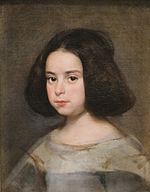
|
Retrato de niña | 1640 | 51.5 × 41 | Hispanic Society of America, New York City | Unfinished according to López-Rey, highlighting the vigorous brushstrokes in the garment,[25] and "one of the most captivating female portraits by Velazquez," according to Brown.[26] | 92/97 |

|
Portrait of Francisco Lezcano | 1643–1645 | 107.5 × 83.5 | Museo del Prado, Madrid | 93/99 | |

|
Portrait of Philip IV in Fraga | 1644 | 129.8 × 99.4 | Frick Collection, New York City | 94/100 | |

|
The Jester Don Diego de Acedo | 1645 | 106 × 82.5 | Museo del Prado, Madrid | 96/102 | |

|
Portrait of Sebastián de Morra | 1645 | 106 × 81.5 | Museo del Prado, Madrid | 97/103 | |

|
Coronation of the Virgin | 1645 | 178.5 × 134.5 | Museo del Prado, Madrid | 98/105 | |

|
Rokeby Venus | 122.5 × 177 | National Gallery of London | 100/106 | ||

|
Female Figure | 1644-1648 | 64 × 58 | Meadows Museum, Dallas | 101/108 | |

|
La infanta María Teresa | 1648 | 48 × 37 | Metropolitan Museum of Art, New York City | 102/109 | |

|
Un caballero de la Orden de Santiago | 1645–1650 | 67 × 56 | Gemäldegalerie Alte Meister, Dresden | 103/110 |
Second trip to Italy (1649–1651)
[edit]| Painting | Title | Date | Dimensions (cm) | Collection | Notes | Catalog numbers: Morán–Sánchez/López-Rey |
|---|---|---|---|---|---|---|

|
Portrait of Juan de Pareja | 1649–1650 | 81.3 × 69.9 | Metropolitan Museum of Art, New York City | 104/112 | |

|
Ferdinando Brandani | 1650 | 50.5 × 47 | Museo del Prado, Madrid | 105/113 | |

|
Portrait of Innocent X | 1650 | 140 × 120 | Doria Pamphilj Gallery, Rome | Signature on the role held by the pope: "Alla santa di Nro Sigre / Innocencio Xº / Per / Diego de Silva / Velázquez dela Ca / mera di S. Mte Cattca" | 106/114 |

|
Innocent X | 1650 | 82 × 71.5 | Apsley House, London | 107/115 | |

|
Camillo Massimi | 1650 | 73.6 × 58.5 | Kingston Lacy, Dorset | 108/116 | |

|
El cardenal Astalli | 1650–1651 | 61 × 48.5 | Hispanic Society of America, New York City | 109/117 |
Madrid (1651–1660)
[edit]| Painting | Title | Date | Dimensions (cm) | Collection | Notes | Catalog numbers: Morán–Sánchez/López-Rey |
|---|---|---|---|---|---|---|

|
María Teresa, infanta de España | 1651–1652 | 34.3 × 40 | Metropolitan Museum of Art, New York City | The work has been cut.[27] Critics have unanimously considered it by Velázquez. Brown (1986) believes that it could be a study used as a model for later portraits.[28] | 110/118 |

|
Portrait of the Infanta Maria Theresa of Spain | 1651–1653 | 127 × 98.5 | Kunsthistorisches Museum, Vienna | 111/119 | |

|
Felipe IV | 1653–1655 | 69 × 56 | Museo del Prado, Madrid | 112/120 | |

|
Portrait of Mariana of Austria | 1652–1653 | 234 × 131.5 | Museo del Prado, Madrid | Painted on a portrait of the king, perhaps only sketched. López-Rey said, confirmed in the technical study conducted at the Museo del Prado, that the top of the curtain was painted by another hand on a piece of fabric added to the original composition, in order to match the canvas with Philip IV with a lion, the Museo del Prado, the work of the workshop.[29][30] | 113/121 |

|
La infanta Margarita | 1653 | 128.5 × 100 | Kunsthistorisches Museum, Vienna | 114/122 | |

|
La infanta Margarita | 1656 | 105 × 88 | Kunsthistorisches Museum, Vienna | 115/123 | |

|
Las Meninas | 1656–1657 | 318 × 276 | Museo del Prado, Madrid | 116/124 | |

|
Las Hilanderas or The Fable of Arachne | c. 1657 | 167 × 252 | Museo del Prado, Madrid | The addition of a new section to the upper portion of the canvas was probably the result of repair after the fire at the Alcázar in 1734. | 117/107 |

|
La reina Mariana de Austria | 1655–1656 | 46.5 × 43 | Meadows Museum, Dallas | Probably an unfinished study.[31] | 118/125 |

|
Mercurio y Argos | 1659 | 128 × 250 | Museo del Prado, Madrid | Painted for the Hall of Mirrors in the Alcazar with three other paintings of mythological subjects missing in the fire of 1734. | 120/127 |

|
Infanta Margarita Teresa in a Blue Dress | 1659 | 127 × 107 | Kunsthistorisches Museum, Vienna | 121/128 | |

|
Portrait of Prince Philip Prospero | 1659 | 128.5 × 99.5 | Kunsthistorisches Museum, Vienna | 122/129 |
Paintings of debated attribution
[edit]| Painting | Title | Date | Dimensions (cm) | Collection | Notes | Catalog numbers: Morán–Sánchez/López-Rey |
|---|---|---|---|---|---|---|

|
Education of the Virgin | 1617-1618 | Yale University Art Gallery, New Haven | Thought to have been given to Yale in 1925, the painting has previously been attributed to the 17th-century Spanish school. Some scholars are prepared to attribute the painting to Velázquez, though the Prado Museum in Madrid is reserving judgment. The work will be restored by conservators at Yale.[32][33] | ||

|
La mulata | 1620 | 55 × 104.5 | Art Institute of Chicago, Chicago | Brown and others cannot rule out the work of a copyist.[34] | 4/18 |

|
Cabeza de hombre joven de perfil | 1618–1619 | 39.5 × 35.8 | Hermitage Museum, Saint Petersburg | 7/8 | |

|
The Farmers' Lunch | 1618–1619 | 96 × 112 | Museum of Fine Arts, Budapest | 8/9 | |

|
La Immaculada | 1618–1620 | 142 × 98.5 | Centro de Investigación Diego Velázquez, Fundación Focus-Abengoa Sevilla | Presented in Paris in 1990 as the work of Velazquez's circle. Sotheby's auction in London (1994) with attribution to Velazquez relying on the favorable opinion of José López-Rey and Jonathan Brown.[35][36] This is rejected by Alfonso E. Perez Sanchez, who assigns it to Alonso Cano.[37] | |

|
Las lágrimas de San Pedro | 1618–1619 | 132 × 98.5 | Colección Villar-Mir, Madrid | ||

|
San Juan Bautista en el desierto | 1620 | 175.3 × 152.5 | Art Institute of Chicago | ||

|
Retrato de un clérigo | 1622–1623 | 66.5 × 51 | Colección Payá, Madrid | Inscription "AETATIS SVAE. 40-". Presented by Mayer in 1936, López-Rey admits as Velázquez, noting its poor condition, and thinks that the portrait could be of Francisco de Rioja.[38] For Brown, only "possibly Velázquez".[39] | 23/26 |

|
A gentleman (Juan de Fonseca?) | 1623 | 52 × 40 | Detroit Institute of Arts, Detroit | ||

|
El venerable padre fray Simón de Rojas difunto | 1624 | 101 × 121 | Colección de los duques del Infantado, Madrid | Inscriptions: "AVE MARIA" and at top right, "El RºP.M. Fr. Simon D. Roxas". Antonio Palomino notes that Velazquez painted a portrait of Simon de Rojas "being dead".[40] Identified by Pérez Sánchez in a Madrid private collection, attributed to Francisco de Zurbarán.[41] | |
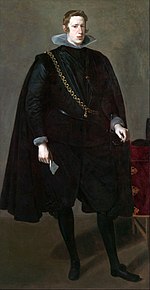
|
Felipe IV | 1624 | 200 × 102.9 | Metropolitan Museum of Art, New York City | 26/29 | |

|
Portrait of the Count-Duke of Olivares | 1624 | 201.2 × 111.1 | São Paulo Museum of Art, São Paulo | 27/30 | |

|
El conde-duque de Olivares | 1624–1626 | 216 × 192.5 | Hispanic Society of America, New York City | Inscriptions: "el Conde Duque" and a barely legible "A 25". | 29/32 |

|
El conde-duque de Olivares | 1624–1625 | 209 × 111 | Colección Várez Fisa, Madrid | In poor condition; the surface is badly damaged except for the head. Excluded from the catalog by López-Rey and Brown, among others. | 30/– |

|
Retrato de hombre | 1626–1628 | 104 × 79 | Museo Soumaya, Mexico City | Problematic for López-Rey, because of the poor condition.[42] For Brown, "possibly by Velazquez".[43] | –/34 |

|
Felipe IV con jubón amarillo | 1628 | 205 × 117 | John and Mable Ringling Museum of Art, Sarasota, Florida | Rejected by López-Rey and Brown, but defended by Julian Gallego when exhibited in 1990 at the Museo del Prado.[44] | |

|
El bufón Calabacillas | 1626–1632 | 175.5 × 106.5 | Cleveland Museum of Art, Cleveland | Rejected by Brown.[45] | 36/39 |

|
Portrait of a Clergyman (Self-portrait?) | 1630 | 67 × 50 | Capitoline Museums, Rome | ||

|
Riña entre soldados ante la embajada de España / "La rissa" | 1630 | 28.9 × 39.6 | Colección Pallavicini, Rome | Oil on copper. Attributed to Velazquez by Roberto Longhi, noting similarities with The Forge and Joseph's Tunic, a thesis defended by Marini and Salort, who noted the exceptional technical quality.[46] | |

|
Santa Rufina | 1632–1634 | 77 × 64 | Centro de Investigaciones Diego Velázquez, Fundación Focus-Abengoa, Seville | ||

|
Portrait of a Man | 1630 | 68.6 × 55.2 | Metropolitan Museum of Art, New York City | Posited by Mayer in 1917 as a self-portrait, relating to one of the characters in The Surrender of Breda. Cataloged in the museum as a work of the workshop, after exclusion by López-Rey, but has again been attributed to Velazquez with the support of Jonathan Brown after cleaning in 2009.[47] | |

|
Portrait of a Man | 1630 | Otto Naumann, New York City | Rediscovered in 2010, sold at an auction in London for $4.7 million in 2011 to New York dealer Otto Naumann.[48] | ||
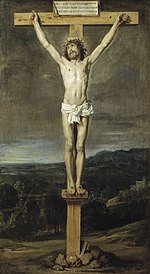
|
Cristo en la cruz | 1631 | 100 × 57 | Museo del Prado, Madrid | Signed "Do. Velazquez fa. 1631", which may or may not be a later addition to the painting. | |

|
Dama joven | 1635 | 98 × 49 | Collection of the Duke of Devonshire, Chatsworth, Derbyshire, United Kingdom | 76/80 | |

|
San Antonio Abad | 1635–1638 | 55.8 × 40 | Private collection, New York City | ||

|
La tela real | 1636–1638 | 182 × 302 | National Gallery of London | 85/- | |
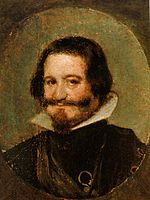
|
El conde-duque de Olivares | 1638 | 10 × 8 | Palacio Real de Madrid, Madrid | Oil on copper. Some documents show that Velázquez painted portraits in miniature on copper, including some members of the royal family. | 83/88 |

|
Don Francisco Bandrés de Abarca | 1638–1646 | 64 × 53 | Private collection, Switzerland | Supported by López-Rey, while noting the poor condition (possibly a fragment half-length portrait) and lack of resemblance to other portraits of the same period.[49] | |

|
Retrato ecuestre de Felipe IV | 1645 | 393 × 267 | Uffizi, Florence | 95/101 | |

|
El bufón don Sebastián de Morra | 1645 | 106 × 84.5 | Private collection, Switzerland | ||

|
Juan Francisco Pimentel, conde de Benavente | 1648 | 109.5 × 88.5 | Museo del Prado, Madrid | Exhibited at the museum as "attributed" to Velazquez and excluded by López-Rey and Brown, but supported by Gallego in the exhibition of 1990, Marias (1996) and Bottineau (1998). | 99/- |

|
La gallega | 1645–1650 | 60 × 46.5 | Private collection, Switzerland? | Unfinished. Rejected by Brown.[50] | |

|
Cristoforo Segni | 1650–1651 | 114 × 92 | Private collection | Thought to have been conceived entirely by Velázquez who also painted at least the head. The rest of the painting was done by Pietro Martire Neri.[51] | |

|
La infanta Margarita | 1653 | 115 × 91 | Collection of the Dukes of Alba, Madrid | ||

|
Felipe IV | 1656–1657 | 64 × 53.75 | National Gallery of London | 123/- | |

|
La reina Mariana de Austria | 1656–1657 | 64.7 × 54.6 | Thyssen-Bornemisza Museum, Madrid | Excluded by Brown. | 119/126 |
Drawings
[edit]| Drawing | Title | Date | Medium | Dimensions (cm)s | Collection | Notes | Catalog numbers: Brown/López-Rey |
|---|---|---|---|---|---|---|---|

|
Busto de muchacha | 1618 | Charcoal on paper | 20 × 13.5 | Biblioteca Nacional de España, Madrid | For Brown this and the following are "possibly Velázquez." | DQ6/4 |

|
Cabeza de muchacha | 1618 | Charcoal on paper | 15 × 11.7 | Biblioteca Nacional de España, Madrid | DQ1/5 | |

|
Study for Cristo contemplado por el alma cristiana | 1626–1628 | Earlier in the Jovellanos Institute, Gijón | Destroyed in 1936. | DQ5/35b | ||

|
Study for The Surrender of Breda | 1634–1635 | Black pencil on paper | 26.2 × 16.8 | Biblioteca Nacional de España, Madrid | D2a/74 | |

|
Study for the figure of General Spinola in The Surrender of Breda | 1634–1635 | Black pencil on paper | 26.2 × 16.8 | Biblioteca Nacional de España, Madrid | Drawn on the back of the former. | D2b/75 |

|
Retrato de don Gaspar de Borja y Velasco | 1643–1645 | Black pencil on paper | 18.6 × 11.6 | Real Academia de Bellas Artes de San Fernando, Madrid | Study for a lost portrait. | D1/98 |
Notes
[edit]- ^ Vogel, Carol (September 10, 2009). "An Old Spanish Master Emerges From Grime". The New York Times. Retrieved September 11, 2009.
Jonathan Brown, this country's leading Velázquez expert ... "Velázquez was a painter who measured out his genius in thimblefuls." His output was so small that, depending on who's counting, Mr. Brown estimates, there are only 110 to 120 known canvases by the artist.
- ^ López-Rey, p. 46.
- ^ Morán Turina and Sánchez Quevedo, p. 50.
- ^ López-Rey, p. 48.
- ^ Garrido Pérez, pp. 94–95.
- ^ Morán Turina and Sánchez Quevedo, p. 64.
- ^ Brown, Velázquez, pintor y cortesano, pp. 45–46.
- ^ López-Rey, p. 64.
- ^ Morán Turina and Sánchez Quevedo, p. 72
- ^ Morán Turina and Sánchez Quevedo, p. 78
- ^ López-Rey, p. 76.
- ^ Garrido Pérez, p. 155.
- ^ Morán Turina and Sánchez Quevedo, p. 86
- ^ Morán Turina and Sánchez Quevedo, p. 90
- ^ Morán Turina and Sánchez Quevedo, p. 94
- ^ Morán Turina and Sánchez Quevedo, p. 102.
- ^ Morán Turina and Sánchez Quevedo, p. 104.
- ^ López-Rey, p. 120.
- ^ Brown, Velázquez, pintor y cortesano, pp. 140–141.
- ^ López-Rey, p. 134.
- ^ Morán Turina and Sánchez Quevedo, p. 134
- ^ López-Rey, Velázquez, p. 181
- ^ Garrido Pérez, pp. 367–383.
- ^ Morán Turina and Sánchez Quevedo, p. 188.
- ^ López-Rey, p. 236.
- ^ Brown, Velázquez, pintor y cortesano, p. 156.
- ^ Metmuseum, base de datos.
- ^ Morán Turina and Sánchez Quevedo, p. 236.
- ^ López-Rey, Velázquez, p. 185.
- ^ Garrido Pérez, pp. 527–537.
- ^ Morán Turina and Sánchez Quevedo, p. 252.
- ^ Giles Tremlett in Madrid (July 1, 2010). "Yale basement yields Spanish treasure – a possible Velázquez masterpiece". The Guardian. UK. Retrieved December 22, 2010.
- ^ "Yale uncovers Velazquez in basement storage". CBC News. July 3, 2010. Retrieved December 22, 2010.
- ^ Brown, Velázquez, pintor y cortesano, p. 21.
- ^ Marini, p. 39, note 1.
- ^ Navarrete Prieto, Benito, "Velázquez y Sevilla: la Inmaculada del Deán López Cepero recuperada", Ars Magazine, July–September 2009, pp. 100–117.
- ^ Pérez Sánchez, Novedades velazqueñas, pp. 386–390.
- ^ López-Rey, p. 60.
- ^ Brown, Velázquez, pintor y cortesano, p. 282.
- ^ Palomino, p. 233
- ^ Pérez Sánchez, "Novedades velazqueñas", pp. 371–390.
- ^ López-Rey, p. 80.
- ^ Brown, Velázquez, pintor y cortesano, p. 47.
- ^ "Catálogo de la exposición Velázquez" (1990), pp. 139–141.
- ^ Brown (2008), Escritos completos sobre Velázquez, pp. 370–372.
- ^ Salort, Velázquez en Italia, pp. 296–301.
- ^ Metropolitan Museum of Art. Velázquez Rediscovered exhibit, New York, 2009, with text by Keith Christiansen, Michael Gallagher and Jonathan Brown.
- ^ Bloomberg. Velazquez Portrait Sells for $4.7 Million at London Auction
- ^ López-Rey, p. 232.
- ^ Brown (2008), Escritos completos sobre Velázquez, pp. 411–414 and 376, note 28.
- ^ "Diego Rodríguez de Silva y Velázquez and Pietro Martire Neri". Sothebys. Retrieved 12 July 2023.
Sources
[edit]- Bardi, P.M. (1969). "Documentación sobre el hombre y el artista". La obra pictórica completa de Velázquez. Barcelona: Editorial Noguer SA y Rizzoli Editores.
- Brown, Jonathan (1986). Velázquez. Pintor y cortesano. Madrid: Alianza Editorial. ISBN 84-206-9031-7.
- Brown, Jonathan y Garrido, Carmen (1998). Velázquez. La técnica del genio. Madrid: Ediciones Encuentro. ISBN 84-7490-487-0.
{{cite book}}: CS1 maint: multiple names: authors list (link) - Brown, Jonathan (2008). Escritos completos sobre Velázquez. Madrid: Centro de Estudios Europa Hispánica. ISBN 978-84-9360-605-3.
- Catálogo de la exposición (1990). Velázquez. Madrid: Museo Nacional del Prado. ISBN 84-87317-01-4.
- Catálogo de la exposición (1996). Obras maestras del arte español. Museo de Bellas Artes de Budapest. Madrid: Banco Bilbao Vizcaya. ISBN 84-860-2288-6.
- Catálogo de la exposición (1999). Velázquez y Sevilla. Sevilla: Junta de Andalucía. Consejería de Cultura. ISBN 84-8266-098-5.
- Catálogo de la exposición (1999). El dibujo europeo en tiempos de Velázquez. Madrid: Real Academia de Bellas Artes de San Fernando. ISBN 84-898-9514-7.
- Catálogo de la exposición (1999). Velázquez, Rubens y Van Dyck. Madrid: Museo Nacional del Prado. ISBN 84-87317-86-3.
- Catálogo de la exposición (1999). Velázquez a Roma Velázquez e Roma. Roma: Galería Borghese. ISBN 88-8118-669-1.
- Catálogo de la exposición (2005). De Herrera a Velázquez. El primer naturalismo en Sevilla. Bilbao Sevilla: Museo de Bellas Artes de Bilbao-Fundación Focus Abengoa. ISBN 84-898-9514-7.
- Catálogo de la exposición (2007). Fábulas de Velázquez. Madrid: Museo del Prado. ISBN 978-84-8480-129-0.
- Garrido Pérez, Carmen (1992). Velázquez, técnica y evolución. Madrid: Museo del Prado. ISBN 84-87317-16-2.
- Gudiol, José (1982). Velázquez. Barcelona: Ediciones Poligrafa SA. ISBN 84-343-03531.
- López-Rey, José (1978). Velázquez. Barcelona: Compañía Internacional Editora S. A. ISBN 84-85004-74-4.
- López-Rey, José (1996). Velázquez. Catalogue raisonné, vol. II. Colonia: Taschen Wildenstein Institute. ISBN 3-8228-8731-5.
- Marías, Fernando (1999). Velázquez. Pintor y criado del rey. Madrid: Nerea. ISBN 84-89569-33-9.
- Marini, Maurizio (1997). Velázquez. Madrid: Electa. ISBN 84-8156-160-6.
- Morán Turina, Miguel & Sánchez Quevedo, Isabel (1999). Velázquez. Catálogo completo. Madrid: Ediciones Akal SA. ISBN 84-460-1349-5.
- Palomino, Antonio (1988). El museo pictórico y escala óptica III. El parnaso español pintoresco laureado. Madrid: Aguilar S.A. de Ediciones. ISBN 84-03-88005-7.
- Pérez Sánchez; Alfonso E. (1996). "Escuela española". El Museo del Prado. Fundación Amigos del Museo del Prado y Fonds Mercator. ISBN 90-6153363-5.
- Pérez Sánchez; Alfonso E. (1999). "Novedades velazqueñas". Archivo Español de Arte nº 72. Consejo Superior de Investigaciones Científicas.
- Ragusa, Elena (2004). "La vida y el arte.". Velázquez. Milan: RCS Libri S.p.A. ISBN 84-89780-54-4.
- Ragusa, Elena (2004). "Breve antología crítica". Velázquez. Milán:RCS Libri S.p.A. ISBN 84-89780-54-4.
- Salort Pons, Salvador (2002). Velázquez en Italia. Madrid: Fundación de Apoyo a la Historia del Arte Hispánico. ISBN 84-932891-1-6.
